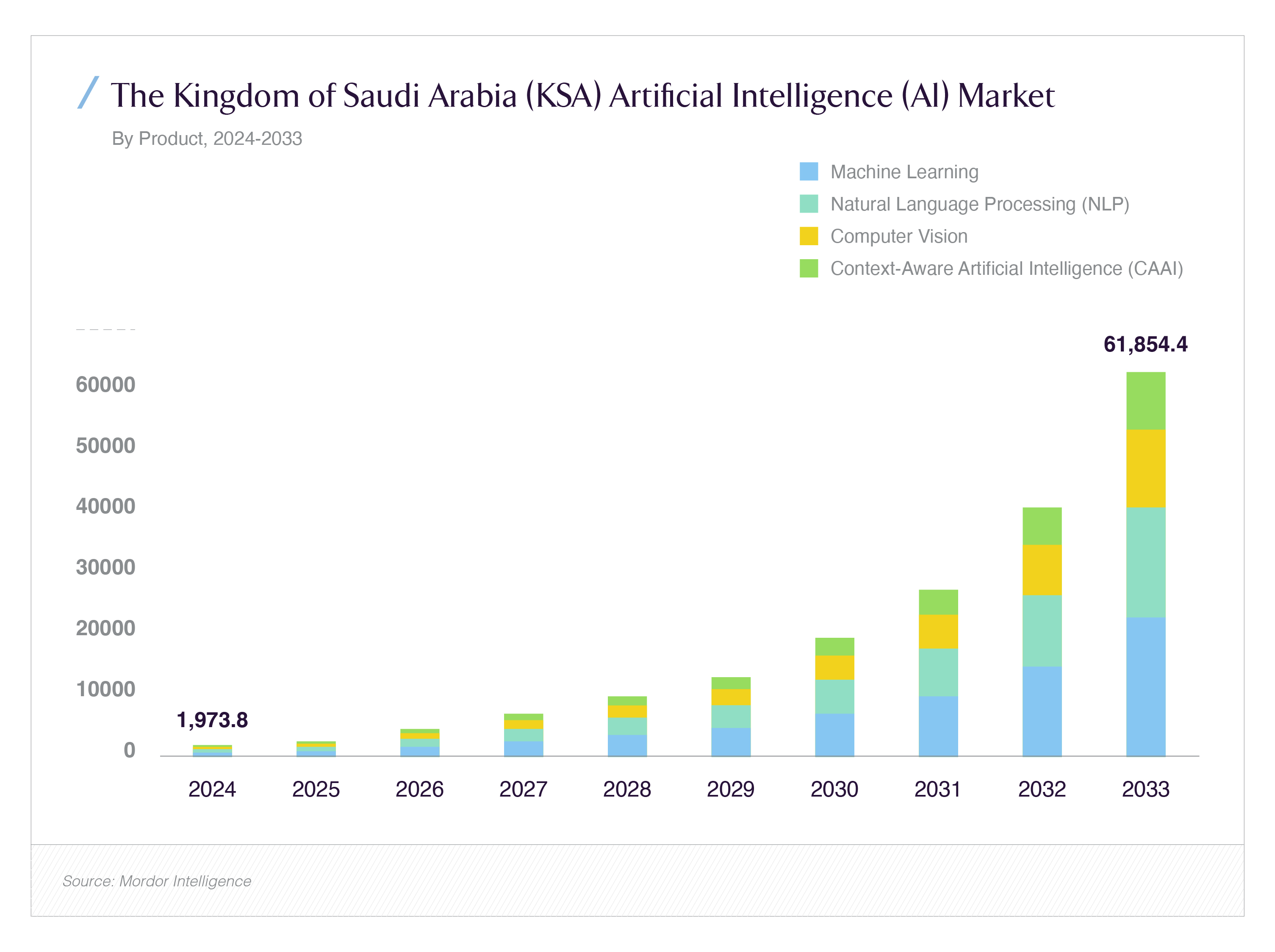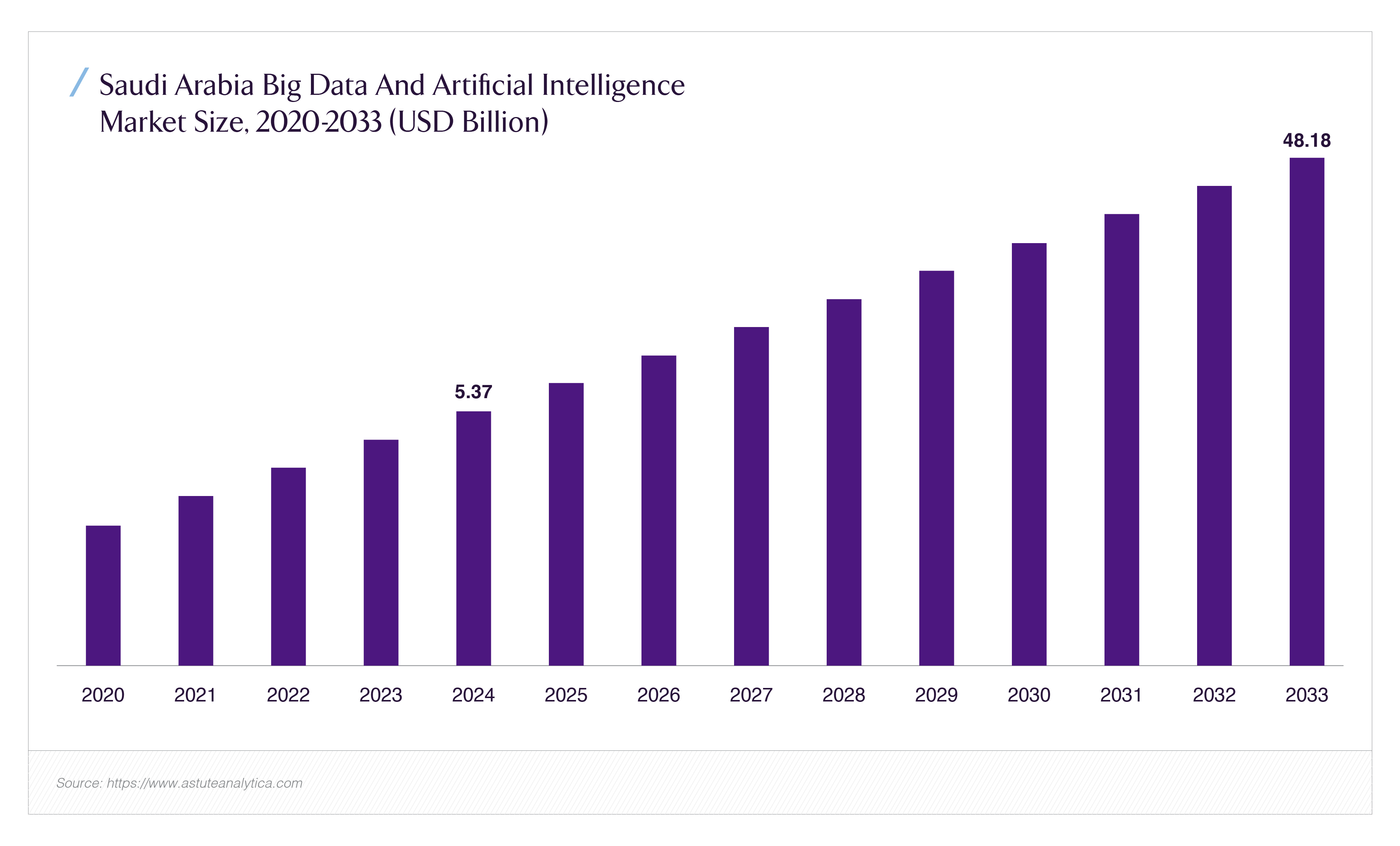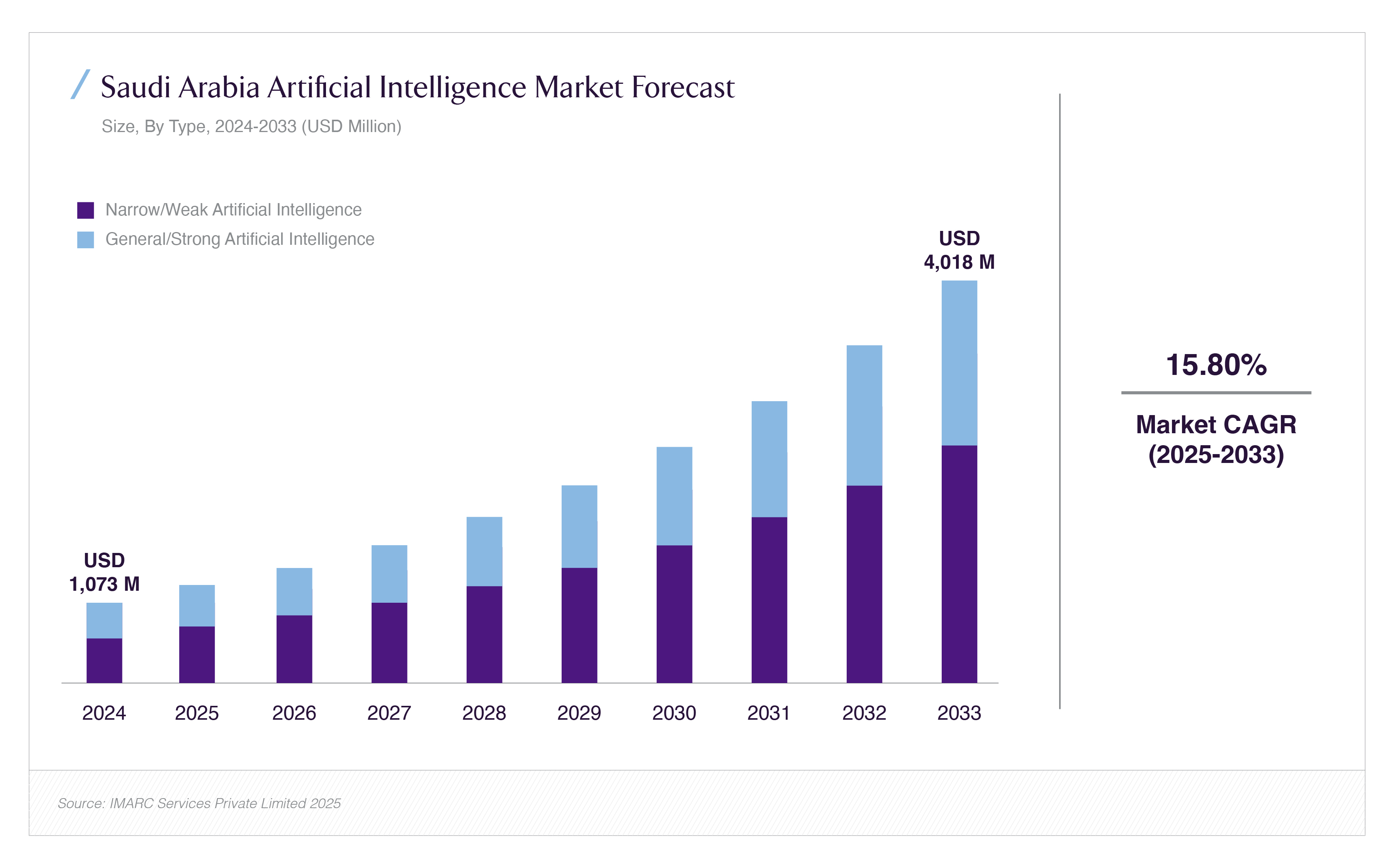The Kingdom of Saudi Arabia aims to become a leading force in AI by investing $40 billion. However, this vision can only be achieved if skilled workers are involved, not just money. This article examines whether the Kingdom’s current educational and training systems can supply enough AI talent.
Building the AI Workforce

Source: Dimension Market Research
AI is now being included in the courses offered by Saudi universities. So far, 86% of these institutions give students the option of an AI undergraduate degree, 56% have set up master’s programs in AI and 9% offer doctoral degrees in the field. This move demonstrates that the Kingdom is committed to developing its technology professionals.
The educational change has been led by King Fahd University of Petroleum and Minerals (KFUPM) in Dhahran. There are 38 undergraduate concentrations and 32 one-year professional master’s degrees in Artificial Intelligence, Quantum Computing and Smart and Sustainable Cities available at the university. These initiatives are helping students develop the skills needed for the Kingdom’s AI efforts.
KAUST has made significant contributions to the field of AI education and research. Last July, KAUST launched four Centers of Excellence centered on Renewable Energy and Storage Technologies, Smart Health, Generative AI and Sustainable Food Security. They are established to support research, development and innovation in line with Saudi Arabia’s main goals.
AI-related courses are being offered more widely in Saudi universities: 86% provide AI degrees at the undergraduate level, 56% have master’s programs in AI and 9% offer doctoral programs in this field. During this time, AI-related graduate numbers increased by 42%, proving the Kingdom is investing in homegrown technology expertise
National Initiatives
The Saudi Data and Artificial Intelligence Authority (SDAIA) has helped the population learn the skills required for an AI-driven economy. SDAIA has educated more than 45,000 people through different programs in data and AI skills. The company is spearheading the “Elevate” initiative, which aspires to train over 25,000 women in data and AI over the next five years. Its goal is to help women achieve greater involvement in the tech industry.
Moreover, SDAIA has partnered with international colleges to provide courses and scholarships that boost the Kingdom’s skills in data and AI. The Saudi Data and Artificial Intelligence Authority (SDAIA) has helped a lot in training the population: More than 779,000 citizens have received data and AI training. The group consists of 9,775 specialists and 260 scientists, and experts. Through the “Elevate” program and the SAMAI initiative, SDAIA is working hard to increase AI knowledge in different fields.
Attracting skilled workers from other countries and joining forces with international partners is another way Saudi Arabia is supporting its AI industry. The Kingdom is now 15th in the world for attracting AI talent, compared to 24th last year. Researchers have gained new tools and learned about best practices worldwide through partnerships with Google. For example, KAUST’s partnership with Google has greatly contributed to the progress of AI studies in Saudi Arabia. The goal is to fill the skill gap and introduce a variety of ideas into Saudi Arabia’s AI efforts.
Strategic Objectives

The $40 billion Saudi Arabia plans to invest in AI is meant to help the economy and modernize the country’s healthcare, education and energy sectors. The effort is important to the Vision 2030 plan, working to wean Saudi Arabia off oil by increasing its economy and helping create jobs in modern technology businesses.
The Saudi government is working on developing advanced and automated medical systems in healthcare. As a result, these technologies can operate on their own and allow for speedier and more accurate care. With this technology, patients might wait less in hospitals, receive better care and pay less for healthcare. The plan is to get hospitals and clinics in the Kingdom to use AI technologies on a large scale by 2030. As a result, Saudi hospitals are projected to decrease their costs and the time it takes to diagnose patients by 30% with the help of AI-driven automation by 2030.
Investment is also focused on the education sector. The government of Saudi Arabia is planning to use AI in educational applications in schools and universities. Students can learn better on these platforms, as they are tailored to each person’s learning style. The Ministry of Education aims for AI to increase student success in STEM subjects by at least 20% by the year 2030. Moreover, they will help bring high-quality education to remote places which will reduce differences among regions.
Saudi Arabia is using AI to improve how energy is produced and reduce the amount of waste. The nation which is a major producer of oil, is improving its processes using smart technology, aiming to cut energy waste by 15% by 2030. As a result, these systems will help the country reach its goal of generating 50% of electricity from solar and wind by 2030.
The fund will also help create new research centers focused on different areas of science across the United States. They will work together with top universities and technology companies to promote research and development in AI. It is important to note that the Kingdom plans to have at least five major AI research centers by the year 2027, with thousands of local and foreign experts employed there.
Global Tech Collaborations
International technology companies are helping Saudi Arabia reach its ambitious targets. As an example, the Kingdom is now negotiating with Andreessen Horowitz, a top venture capital firm from Silicon Valley. If things go well, the firm might open an office in Riyadh to offer key support for startups and new ideas in the area. Making this move could appeal to hundreds of technology entrepreneurs and result in thousands of new tech jobs in the coming decade.
The country has also partnered with Nvidia and AMD, who will provide the necessary advanced technology for running AI models. The partnerships are set to improve Saudi Arabia’s computer systems and support local scientists in creating advanced and innovative AI technologies.
Amazon Web Services (AWS) has revealed that it will create an AI Zone in Saudi Arabia, investing around $5 billion. Thanks to this investment, the Kingdom’s cloud computing will improve, making it easy for businesses and government agencies to adopt new technologies. By the end of this decade, the zone should be home to thousands of tech firms and provide more than 10,000 jobs in AI and cloud services.
Establishing Humain
One of the main goals in Saudi Arabia’s AI plan is to launch Humain on May 12, 2025. Saudi Arabia’s Public Investment Fund (PIF) owns the new AI company Humain. The main goal of the company is to construct advanced data centers and create AI tools designed for Arabic language usage. Humain aims to build the leading Arabic-language AI models, helping many local industries and sectors within the government.
Humain is designed to help Saudi Arabia become the top Arabic AI nation, as the market for this technology is predicted to expand swiftly. The initiative aims to provide many high-tech jobs and improve Saudi Arabia’s research and use of AI.
Road Ahead

While there has been much improvement, it is still difficult to build a workforce that can achieve the Kingdom’s AI goals. Because AI initiatives are growing so fast, there are now more jobs for skilled people than there are people with the skills. It is very important for educational programs to evolve along with AI. Collaboration between universities and private companies can improve students’ skills and help them get ready for work.
It is also necessary to deal with the gender difference in the tech sector. While “Elevate” is a helpful move, the work does not stop until all people are included in AI-related careers.
Conclusion
The country is showing its commitment to AI by investing in education, training and forming partnerships with other nations. Although there are obstacles, the Kingdom’s plan for AI will support it in meeting its $40 billion target. Keeping an eye on learning new skills, curriculum improvement and building relationships internationally will sustain this success in AI over many years.


















